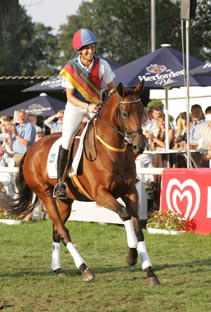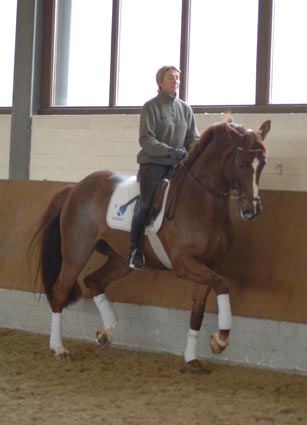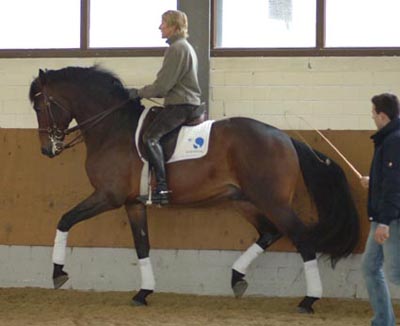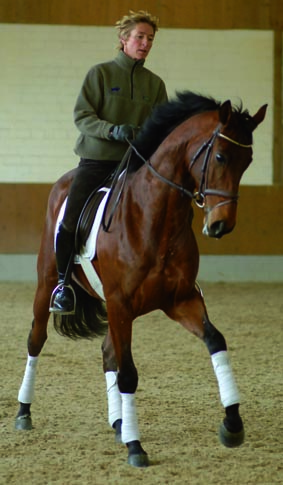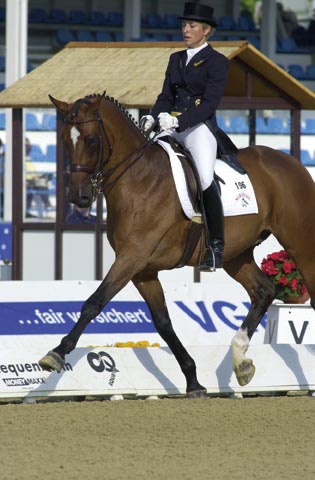When Dr Reiner Klimke died at the age of only 63 in 1999, the equestrian world lost one of its inspirational leaders. Reiner was one of the rider / trainers who introduced the modern, athletic dressage horse, but always, always, trained along the classical lines.
While nothing will ever make up for his untimely departure, his teachings live on through the work of his daughter, Ingrid, who like her father, combines both eventing and dressage at the highest levels.
We were lucky enough to watch Ingrid work at her new base, on the outskirts of Münster – and what was immediately apparent was that Ingrid rode the eventers just like she rode the dressage horses. Later she explained that this was her philosophy…
Ingrid and the young eventer, Seacookie
“I try to work the eventers along the same dressage principles as I school my dressage horses. Only when they jump or have their canter training is it different. The only difference is that I ride the dressage horses more often in dressage training per week, but what I do in that work is totally the same.”
And indeed it is quite something to see an eventer, quietly tossing off four times changes, but that is just what Seacookie TSF (the TSF means he is a Trakehner and is helped in his competition career by the Trakehner Verband) is doing! Earlier this year, Seacookie was second in the CIC** at Marbach.
Are you hoping that sequence changes will come into the eventing dressage test – you are already doing them…
Ingrid laughs: “I heard from Chris Bartle that he has to cut the test for Hong Kong because it is too long – although I don’t think we can make it shorter. We only have a half pass left / right, medium on one side in canter – not even both sides, so I said to him, if we have no time to do the single changes on the loops, what we need to do is four times changes, and do them all on one diagonal!”
“I don’t like to see them shortening the eventing dressage test all the time. It would be nicer to keep it like it is, so you don’t have to hurry in a really short dressage test.”
I thought the balance between dressage / cross country / showjumping, looked about right at the WEG at Aachen?
“Yes, we saw such a big improvement in the tests, so many nice tests, but the cross country was still the one that made the decision, and even in the last showjumping so many places were going up and down. It was not a dressage competition at all.”
Has it made a big difference for eventers in Germany – winning a gold medal at the WEG?
“I think we are much more popular again. After Athens there was a lot of talk that we were unlucky, then the bronze medal at the Europeans, now the gold medal… and in the years before, there was nothing since Seoul in 88. That is such a big gap. Now the reputation of eventing, and the support from the other riders and officials, is much better.”
Are you still as much an event rider as a dressage rider?
“I love the dressage and I love the winter work schooling the horses and bringing them on – but the excitement of the cross country, that is something really thrilling. I wouldn’t like to live without it – that way we least have a few nice highlights in the year. But if I look at the ride with Damon Hill last year in the World Young Dressage horse finals, or the ride with Necktor in the World Cup where the music and the dressage are so nice together… I would love to do both, to have a full schedule, try for good health and try to be a good organizer…”
Above: Seacookie the eventer works over the cavallettis and below, the Grand Prix mare Santa Cruz does the same exercise
But for Beijing, you are looking to eventing?
“Yes, my dressage horses are too young. I think that Lafayette Lord, and also Damon Hill, are good prospects. I want to get going with Robinsons Santa Cruz this year in the Grand Prix, because she is mine – but first I was busy with the eventers in the summer, and then twice injured my shoulder in the winter, so Santa Cruz and I really didn’t get our chance, but I’m looking forward to it because I enjoy her a lot.”
With the eventers finished, Ingrid starts work on her dressage horses – but, when the first one comes out – the big chestnut mare, Robinson’s Santa Cruz – it is apparent that the dressage horses still start the working session over the cavalletti…
“I ride the dressage horses a lot over cavalletti and they also once a week do a little bit of gymnastic jumping. If I have room free on the lorry, then I prefer to take one of the dressage horses to do the hill work as well – that helps them get more muscles in their hind end, builds up their back muscles. If you go up and down hills, it is the best way to strengthen their hind quarters.”
Looking at your training, I don’t understand how so many people manage to get dressage so complicated?
“Yeah, it is really so easy. Just play with them and enjoy it. In the morning I am so happy if I can just turn my mobile phone off, put my cavalletti in the arena, and just work them quietly – take my time, because I think the worst thing is if you rush and have too many students, or too much teaching while you are riding. So now I keep it separate. I take the students in the afternoon, which leaves me totally free in the morning to just focus, play around, and enjoy my horses.”
It is very noticeable that your horses are always in rhythm, every horse, like a metronome…
“I hope so. I always make sure I do a proper warm up. Often in the mornings, my girls will do the warm up and I will do the working, but I make sure, that I start with a warm up on my first horse in the morning, to make sure they are really properly stretching and giving their back, and coming from behind. When you trot over the cavalletti, the hind end is active, they are over the back and soft and swinging.”
“Then they give and stretch into your hand, then you can take them up, have them in front of the vertical and have good contact, because the whole body of the horse is loosened up. If I did this too quick, if I didn’t take the time that each individual horse needs, then I have to struggle with getting any movements properly done. That’s why I always make sure, nice stretching in the beginning, and make sure they stretch afterwards, so then they are ready tomorrow when they come out of the box, they are not tired or muscle sore.”
Certainly, Santa Cruz comes out of her cavalletti work, so free and loose and elastic, with such wonderful ‘takt’ – and even though she is doing the Grand Prix movements, she is working sweetly into a snaffle bit. How nice is this passage? Every step so even, the angles of the horse’s legs so perfectly parallel – this is passage from power, not passage from tension… In the piaffe, she really lowers her quarters, but you can see that the piaffe is still coming and every now and then the mare loses it – and Ingrid just keeps coming back and quietly asking. The piaffe is still not perfect but it will come, and come in the right way.
Time to do the changes, but Ingrid wants to loosen Santa Cruz’s back first, so it is back to a the cavalletti, and cantering over the cavalletti, now that looks different! Lovely changes, nice working pirouette, and the work finishes deep and long and trotting… over the cavalletti.
Next horse in is the exciting dark brown stallion, Lafayette Lord. Again, they start trotting over the cavalletti, but this horse is more of a challenge, he wants to hold his neck up and roll over, just a fraction behind rather than stretching and taking the rein… This is the first time in the morning that Ingrid picks up a stick:
You only rode one horse with a whip?
“Only my big warmblood, heavy blood Lafayette Normally I always ride only with the snaffle and my tiny spurs, because I try to educate both me and my horses; I try to use at home the slightest signals, and not that they are depending on me. I don’t want it that they can’t do piaffe or passage without the whip, because one day I am going to have to do it in the ring without a whip. Lafayette is quite big and heavy, he is a stallion, and it helps me get a little bit more engagement with the whip, otherwise, if I come too much with my leg, he just will say, No! I’m much stronger…”
Robinsons Santa Cruz in passage
The young stallion, Lafayette Lord, gets a helping hand…
And with this horse, Ingrid gets an assistant to come with the whip on the ground…
“If he just goes with me one round and then I do it alone, it is much easier – otherwise I would have to make too much effort from me as a rider on top and the stallion would just tighten. But if somebody goes behind, the person on the ground doesn’t have to do very much, just be there. All the time I try to be more and more independent from him, one round with him, then try alone. If I see, oh he needs a bit more activity, then I ask him again. But it is not that it has to be a work in hand expert, it is more important that the horse knows – oh they really mean it. So it is also an education. Especially with a stallion, they need to know that there is a very clear line, there is nothing in between. They can very quickly start taking over and start educating you… I like Lafayette a lot, because he is such a personality, he is such a macho. The more mares come in to the riding school, the more he says, here I am. And he shows off often in the ring…”
He was the only one that it was not so easy for you to get to go long and stretch?
“He wants to sit back up, and it takes longer to get him to stretch. With Robinsons Santa Cruz, I’ve had her since she was four, she grew up stretching with the cavalletti work, and normally it only takes a few minutes to get her stretching, with him I need longer because he is often focussing on other things. He hears everything outside, so I have to take my time. People ask me – how many minutes? The horse will tell you. Lafayette needs a bit more until he really gives – his body is quite compact, so I need to take my time to stretch him, and not just think, ‘he feels so nice and together’, because he like to ‘sit’…”
With the chestnut mare, her warm up is the model of a classical warm up – is that just her, or because she has always been properly schooled?
“I think it is because she has been worked that way from the beginning. I can sit any of my girls on her, and she does it with all of them now because she knows that warm up so clearly. I often put my students on her and say ‘just warm her up’ because I know she will warm up herself. It’s really that she has been taught that way right from the beginning. My eventer, Seacookie, is very much a Thoroughbred type, he worries about everything, if he sees something or hears something, just a click from the camera and he goes ‘oh, there is something different in my arena’ – he is much more sensitive. So I need even more time to support him, and tell him – ‘you will make it…'”
Seacookie shows us his flying change…
Is it getting easier to get horses in Germany with a lot of Thoroughbred?
“I think so. I have tried several. Abraxxas, who won Luhmühlen CCI**, is full Thoroughbred, although he is Hanoverian branded, and I now have a young mare in training, out of a Thoroughbred mother with a Hanoverian father, so I think if you look, you can find enough Thoroughbred. For the short format, it is more important that you have a nice mover and a good jumper – you can’t only look at the racehorse type. I think Germany is breeding some horses with good potential for eventing.”
All your horses are very very straight in canter, is that something you think about?
“My father, he said always said, sure go on a circle to do your transitions, but then go on a straight line and make sure it is absolutely inside leg / outside hand, diagonal between your aids. That’s why I freshen up in medium on the long side, and make sure the horse is on my seat. But my father was watching a lot for straightness, right from the beginning, to have all four legs absolutely straight – hopefully to keep the horses sound.”
Always your riding seems to be very soft and sympathetic?
“I really enjoy it so much, and I often laugh with them. For example Seacookie is starting to do the changes now, and he is so excited with them, he often does them when I am trying to prepare him for the change, he always says YES and I say WAIT. I think it is really my passion. I enjoy so much the communication that I have with the horse – I try to feel as much as I can into them…”
After Ingrid finishes, there is a new rider in the ring – Helen Langehanenberg on the Rhodiamant mare, Responsible. The pair were recently third in Germany’s prestige small tour competition, the Nürnberger Burg-Pokal. In 2005, Helen took over the ride on Damon Hill after Ingrid broke her leg and rode him to a World Title. Helen has been Ingrid’s student since she was 12, and although she runs her own training centre now, she keeps Responsible at Ingrid’s, so they can work together. Helen is one of the most elegantly beautiful riders in the world… the priceless heritage of Reiner Klimke is in good hands.
Ingrid competing at the European Championships on Nector
This article originally appeared in the July 2007 Horse Magazine


